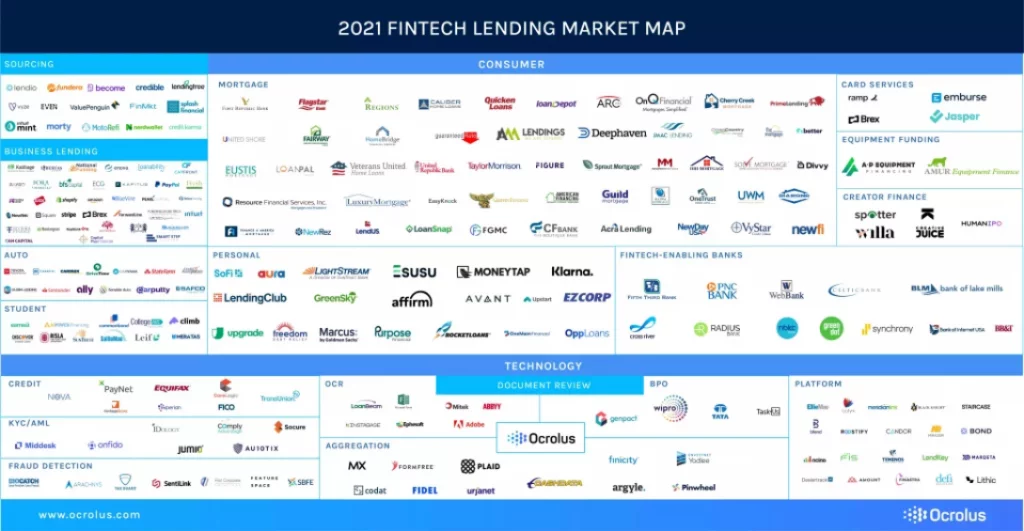This website uses cookies so that we can provide you with the best user experience possible. Cookie information is stored in your browser and performs functions such as recognising you when you return to our website and helping our team to understand which sections of the website you find most interesting and useful.
Fintech Lending: 2021 Market Map and 5 Trends Shaping the Landscape

We’re excited to publish our second annual Fintech Lending Market map shown above. While most of the major players in business, consumer, and mortgage lending – along with their enabling infrastructure – remain the same, there has been a tidal wave of market-shaping developments which have changed this year’s fintech lending landscape. Let’s dive into five of the most impactful trends that are shaping fintech lending today and how certain companies are leading the way.
Five impactful trends shaping the fintech lending market
Fintech lenders took a leadership role in the Paycheck Protection Program (PPP)
In the Spring of 2020, we saw the launch of the SBA’s PPP program that completely changed the small business lending landscape. As funding and loan forgiveness rules were being defined on the fly, large lenders took a conservative approach and focused on loans to larger, more established customers.
Forward-thinking fintech companies took a more nimble approach and quickly developed loan application and documentation platforms to reach out to new clients and provide rapid access to funds to the smallest of businesses
As these entrepreneurial companies initiate post-pandemic business activities, it has become clear that they will continue to need access to capital. The new, trusted relationships developed by fintech lenders will help them accelerate growth in the coming months.
Fintechs becoming banks – banks becoming fintechs?
Bank-fintech partnerships had been gathering momentum before the pandemic, so the idea that fintech lenders would obtain bank charters, either on the state or national level, represents a natural progression. But now, all lenders recognize they need an online presence. We can expect the distinction between legacy bank and fintech lenders to become indiscernible over time.
Square, SoFi, and Lending Club may be seen as pioneers in this movement, but we can expect to see more “chartering” activity as online lending overtakes brick & mortar lending originations. In last year’s fintech lending map, we introduced a category for “fintech enabling banks.” In 2021 that group has grown and the distinction is now blurred; lenders will be thought of based on their constituencies and sub-market specialties:
- Consumer
- Automotive
- Small business
- Equipment leasing
- Invoicing
- Mortgage
Hiring challenges are driving the need for lending efficiency
The changing lending marketplace is not immune to the nationwide shortage of capable and willing employees. While service industries struggle with the dual challenges of higher wages and higher materials costs (in particular, food services and construction) the result will be higher consumer prices. In lending, access to capital among consumers and businesses continues to be critical for growth and economic stability, and the increased competition from fintech companies has raised the bar for all providers of financial services.
Competing on price is insufficient. Whether bank or non-bank, customers will flock to lenders who can increase lending efficiency, reduce decisioning times, provide an excellent customer experience across all channels, and offer the right product, on the right terms, at the right time.
Fraud prevention coming to the forefront
While stories of Ferrari-driving & Rolex-buying fraudsters make the headlines, there has been an undercurrent of understated fraudulent activity across funding sectors. A report by LexisNexus this year indicated that the cost of retail fraud (both retail and ecommerce) increased 7.3% from 2019 to 2020. In a similar report for SMB lending, LexisNexis found lenders experiencing an 8.3% increase in fraudulent activity over a two-year period, with fraud losses as a percentage of revenue having increased an average of 28.6% over the past year.
Fraudsters are becoming more sophisticated, whether in stealing identities, creating synthetic identities, or misrepresenting their ability to repay. Similarly, the fintech solutions for identifying and preventing fraud are growing in diversity and sophistication. Vendors like SentiLink, Middesk, and Socure are receiving more adoption, as document fraud detection and prevention becomes a core technology component of lending infrastructure.

Customer expectations for immediacy in loan approvals
Finally, the move to more online originations, precipitated by COVID restrictions and programs like PPP for urgent funding, has changed consumer and business expectations for loan approval delays. Fintech lenders have known for some time that when a small business needs capital, it is usually not pre-planned well in advance.
Whether 40-day mortgage approvals or 60-day SBA loans, borrowers are questioning why there are unexplained queues with no active progression of their loan status. Fintech lending companies are leveraging their ingrained agility to win more business while still performing necessary due diligence. It’s the effective use of technology that will separate the leaders and laggards in the fintech lending industry.
If you know of a company that should be considered for inclusion in our fintech lending marketing map, share their information with us at pr@ocrolus.com.
Wondering why the world’s top fintech lending companies rely on Ocrolus technology to deliver streamlined and automated financial services to their customers? Schedule a demo today to find out more.





